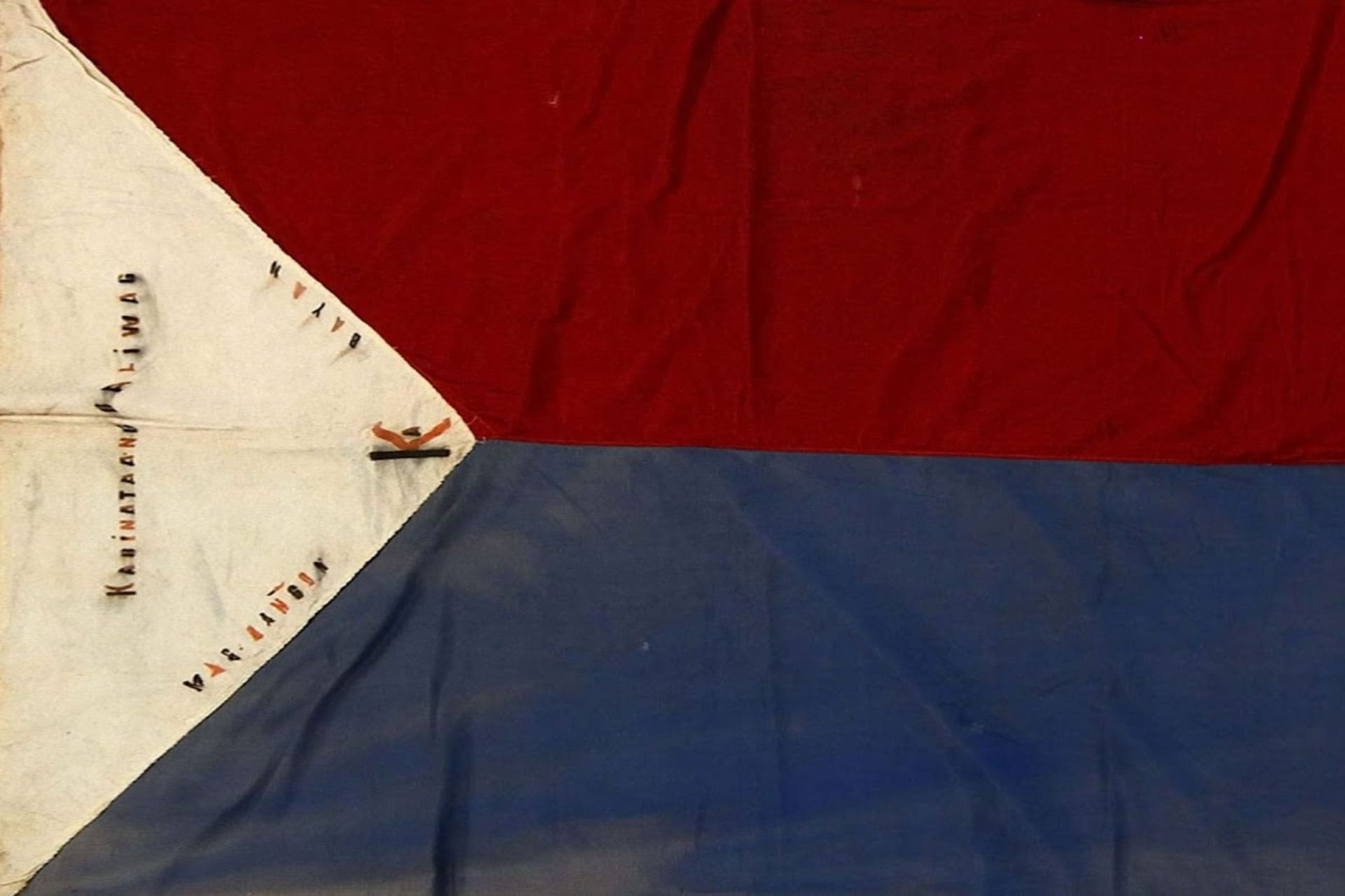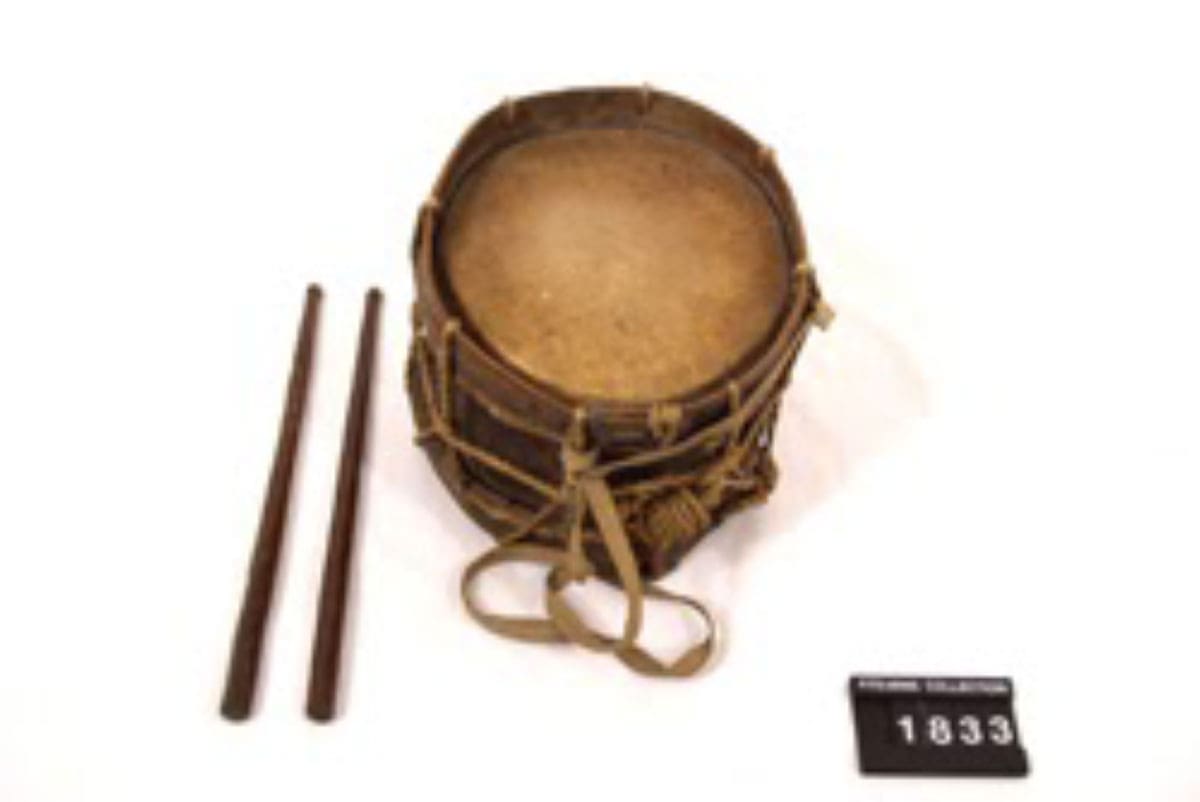
This Philippine flag (watawat in Tagalog) is similar to the official flag of the Philippines, except its sun and stars have been replaced by the words “Kabinataang Baliwag” (Youth of Baliwag) and “Magabangon Ka Bayan” (Rise, country!). Dating back to the Philippine American War, this flag may have been used to symbolize the continued flight for Filipino independence. Museum of Anthropological Archaeology, University of Michigan, 2002
Museum of Anthropological Archaeology
Cultural objects including ceramics, textiles, personal adornments, and basketry-from
the Philippines can be found in the Asian Ethnology and Asian Archaeology collections. Philippine holdings include:
The Beal-Steere Philippine Collection
developed by U-M Professor Joseph Beal Steere in the mid- to late 19th century on the behalf of the University of Michigan to build up its museum collections. The UMMAA’s portion of the Beal-Steere Collection includes (among other objects) assorted weapons, two coats, and a bow for a stringed instrument.
The Philippine Expedition Collection 1922-25
The material from this expedition, led by Dr. Carl E. Guthe, formed UMMAA’s founding collection.
The Dr. Karl Hutterer Collection
of prehistoric archaeology in the Philippines, developed in the 1970s.
The Scheans Collection
created in the late 1960s, composed of ceramic sherds, lithics, and ethnographic materials.
The Tiffany Bernard Williams Collection
consisting of several spears collected by an American soldier serving as constabulary in the Philippines, 1914-1917.
The Bartlett Philippine Collection
including various ethnographic objects collected by an American professor of botany who visited the Philippines several times between 1935 and 1959.
The Cranbrook Institute Collection
of baskets assembled by the Government of the Philippine Islands Bureau of Education.
The Harry E. Smith Collection
developed by an American soldier and hospital administrator during the Philippine-American war and the Spanish-American war.
The Owen A. Tomlinson Collection
composed of a variety of textiles and additional ethnographic objects collected by Tomlinson when he served in the U.S. Army and later the Constabulary in the Philippines, pertaining especially to the mountain province of Ifugao.
The Horace M. Miner Philippine Collection
consists of ethnographic objects including varied weapons, tools, and clothing collected by Dr. James F. Corbett prior to 1955.
The Williams Collection
primarily composed of ceramics found and purchased in the Philippines by G. Mennen Williams and Nancy Q. Williams.
The Chandler Collection
of ethnographic objects, primarily weapons, collected by George M. Chandler between 1926 and 1938.
The Gardner Collection
of Hanunóo and Tagbanua bamboo manuscripts from Mindoro Island and Palawan Island, collected by Guillermo C. Bacal, Ildefonso Maliwanag, and Eusebio Maliwang from 1939 to 1940.
The Solheim Collection
of ceramic potsherds excavated in Calatagan (Batangas), Masbate (Kalanay Cave Site), and Luzon by Wilhelm G. Solheim, the American professor of archaeology.
The Cole Collection
consisting of various ethnographic objects including weapons, textiles, cups, and trays collected by two American teachers in the Philippines, 1901-1903.
The Edwin C. Goddard Philippine Collection
composed of various ethnographic objects including pipes, combs, and cups collected by the University of Michigan professor of law.
The Morse Collection
includes various ethnographic objects including swords, spears, hats, and daggers collected by an American sergeant in the Philippines between 1903 and 1905.
The Trap Philippine Collection
consisting primarily of weapons donated by William M. Trap, head of the Department of Philosophy at Wayne State University and minister at the Christian Reformed Church. The objects were initially collected by John A. Van den Broek, a professor of mechanical engineering at the University of Michigan.
Stearns Collection of Musical Instruments
The Stearns Collection includes at least 13 musical instruments from the Philippine Islands, including drums, flutes, and gong chimes. The collection is partially searchable online.

Snare Drum (#1833), Dalaguete, Philippines. This Snare Drum was acquired on the Island of Cebu during the Guthe Expedition to the Philippines in 1922-1925 for the University of Michigan’s Museum of Anthropology. It was transferred to the Stearns Collection in 1975.
